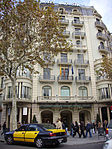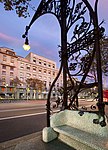Dreta de l'Eixample
EixampleNeighbourhoods of BarcelonaProvince of Barcelona geography stubs

Dreta de l'Eixample (Catalan pronunciation: [ˈdɾɛtə ðə ləˈʃamplə]) is a neighborhood in the Eixample district of Barcelona, Catalonia (Spain). It is located east (visualised as dreta or "right") of Carrer de Balmes. It includes Plaça de Catalunya, the centre of the city, and the upscale streets Rambla de Catalunya and Passeig de Gràcia. It is the bourgeois neighborhood of the city, which makes the majority of its population belong to the upper class of Barcelona. Dreta de L'Eixample is one of the most luxurious neighborhoods of Barcelona.
Excerpt from the Wikipedia article Dreta de l'Eixample (License: CC BY-SA 3.0, Authors, Images).Dreta de l'Eixample
Carrer de València, Barcelona
Geographical coordinates (GPS) Address Nearby Places Show on map
Geographical coordinates (GPS)
| Latitude | Longitude |
|---|---|
| N 41.395277777778 ° | E 2.1666666666667 ° |
Address
Carrer de València 314
08013 Barcelona
Catalonia, Spain
Open on Google Maps








